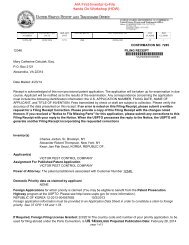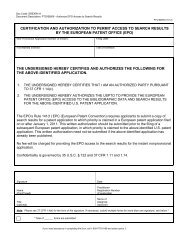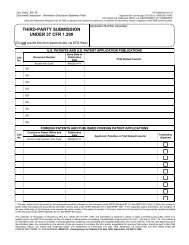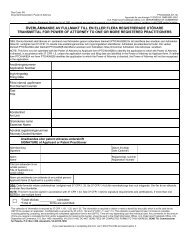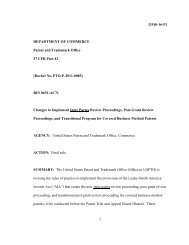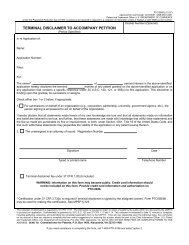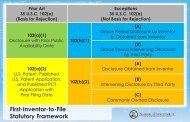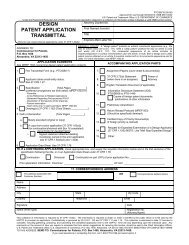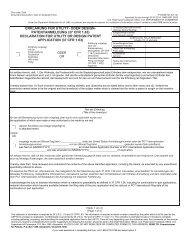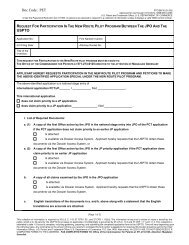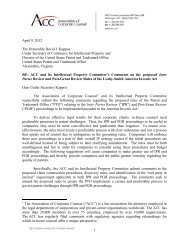USPTO Performance and Accountability Report - U.S. Patent and ...
USPTO Performance and Accountability Report - U.S. Patent and ...
USPTO Performance and Accountability Report - U.S. Patent and ...
You also want an ePaper? Increase the reach of your titles
YUMPU automatically turns print PDFs into web optimized ePapers that Google loves.
92<br />
FINANCIAL SECTION<br />
NOTE 1. Summary of Significant Accounting Policies (continued)<br />
price. Since FY 1993, the <strong>USPTO</strong>’s funding has<br />
been primarily through the collection of user fees.<br />
Fees that are remitted with initial applications <strong>and</strong><br />
requests for other services are recorded as exchange<br />
revenue when received, with an adjustment to defer<br />
revenue for services that have not been performed.<br />
All amounts remitted by customers without a request<br />
for service are recorded as liabilities in customer<br />
deposit accounts until services are ordered.<br />
The <strong>USPTO</strong> also receives financial gifts <strong>and</strong> gifts-inkind.<br />
All such transactions are included in the<br />
consolidated Gifts <strong>and</strong> Bequests Fund financial<br />
statements of the U.S. Department of Commerce.<br />
These gifts are not of significant value <strong>and</strong> are not<br />
reflected in the <strong>USPTO</strong>’s financial statements.<br />
Most gifts-in-kind are used for official travel to further<br />
attain the <strong>USPTO</strong> mission <strong>and</strong> objectives.<br />
Imputed Financing Sources from Cost Absorbed by<br />
Others (<strong>and</strong> Related Imputed Costs): In certain<br />
cases, operating costs of the <strong>USPTO</strong> are paid for in<br />
full or in part by funds appropriated to other federal<br />
entities. For example, Civil Service Retirement System<br />
(CSRS) pension benefits for applicable <strong>USPTO</strong><br />
employees are paid for in part by the U.S. Office of<br />
Personnel Management (OPM), <strong>and</strong> certain legal<br />
judgments against the Department are paid for in<br />
full from the Judgment Fund maintained by Treasury.<br />
Also, the cost of collections for the <strong>USPTO</strong> are paid<br />
for in full by Treasury. The <strong>USPTO</strong> includes applicable<br />
Imputed Costs on the Consolidated Statements of<br />
Net Cost. In addition, an Imputed Financing Source<br />
from Cost Absorbed by Others is recognized on the<br />
Consolidated Statements of Changes in Net Position.<br />
Transfers Out: Intragovernmental transfers of budget<br />
authority without reimbursement are recorded at<br />
book value.<br />
Entity/Non-Entity<br />
Assets that an entity is authorized to use in its operations<br />
are termed entity assets, while assets that are<br />
held by an entity <strong>and</strong> are not available for the entity’s<br />
use are termed non-entity assets. Most of the <strong>USPTO</strong>’s<br />
PERFORMANCE AND ACCOUNTABILITY REPORT: FISCAL YEAR 2012<br />
assets are entity assets <strong>and</strong> are available to carry out<br />
the mission of the <strong>USPTO</strong>, as appropriated by<br />
Congress, with the exception of a portion of the Fund<br />
Balance with Treasury <strong>and</strong> cash. Additional details<br />
are provided in Note 7.<br />
Fund Balance with Treasury<br />
The <strong>USPTO</strong> deposits fees collected in commercial<br />
bank accounts maintained by the Treasury’s Financial<br />
Management Service (FMS). All moneys maintained<br />
in these accounts are transferred to the Federal<br />
Reserve Bank on the next business day following the<br />
day of deposit. In addition, many customer deposits<br />
are wired directly to the Federal Reserve Bank.<br />
All banking activity is conducted in accordance with<br />
the directives issued by the FMS. Treasury processes<br />
all disbursements. Additional details are provided in<br />
Note 2.<br />
Accounts Receivable<br />
Accounts receivable balances are established for<br />
amounts owed to the <strong>USPTO</strong> from its customers.<br />
The <strong>USPTO</strong>’s accounts receivable balances are<br />
comprised of amounts due from former employees<br />
for the reimbursement of education expenses <strong>and</strong><br />
other benefits, amounts due from foreign intellectual<br />
property offices for the reimbursement of services<br />
provided, amounts due from other federal agencies<br />
for the reimbursement of services provided, <strong>and</strong> other<br />
revenue-related receivables. This balance in accounts<br />
receivable remains as a very small portion of the<br />
<strong>USPTO</strong>’s assets, as the <strong>USPTO</strong> requires payment prior to<br />
the provision of goods or services during the course<br />
of its core business activities. Additional details are<br />
provided in Note 3.<br />
The <strong>USPTO</strong> has written off, but not closed out, certain<br />
accounts receivables that are considered not collectible.<br />
These offsets are established for receivables older<br />
than two years with little or no collection activity that<br />
have been transferred to Treasury, subsequently<br />
adjusting the gross amount of its employee-related<br />
accounts receivable to the net realizable value.<br />
The <strong>USPTO</strong> regards all of the intergovernmental receivables<br />
balances as fully collectable.


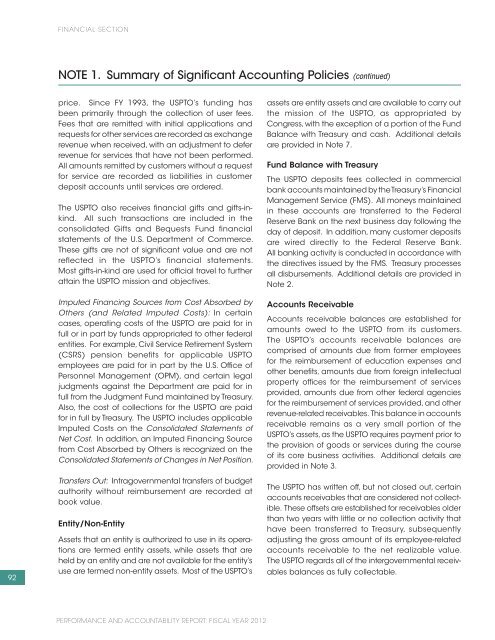
![Printable version [PDF] - United States Patent and Trademark Office](https://img.yumpu.com/51835259/1/184x260/printable-version-pdf-united-states-patent-and-trademark-office.jpg?quality=85)
